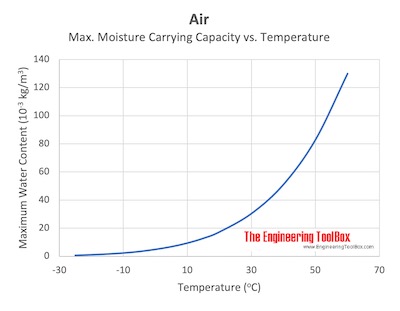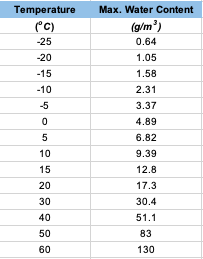Science tells us that people are most comfortable with an indoor temperature range from 20°C – 24°C. In Finland where I live, most houses are set to maintain and indoor temperature of 23°C in the winter. People usually like it a little bit cooler (20°C) in the summer. For sleeping the recommendation is between 15°C – 20°C with the colder side leading to better quality sleep. Our bedroom temperature is usually kept at about 18°C.
Temperature is only half the story
To really understand comfort though, we can’t just look at temperature but must factor in Relative Humidity. By definition Relative Humidity is a measurement of how saturated the air is with water, measured as a percentage. Air that is 100% saturated cannot absorb any more water.
Why this measurement is called relative is because air at different temperatures can hold different amounts of water. Hot air holds significantly more water than cold air. A cubic meter of air at 10°C can hold a maximum of 9.3 grams of water at 100% saturation. Double the temperature to 20°C and that same air can hold a maximum of 17.3 grams of water. At 30°C the air can hold up to 30.4 grams and at 40°C it can hold a maximum of 51.1 grams of water. Notice something here? These numbers aren’t linear as shown by the graph below.

So air at a temperature of 40°C can actually hold 500% more water than air that is 10°C. Factoring in Relative humidity, air that is 10°C with 90% humidity is holding the same 8 grams per cubic meter of water vapor as air at 30°C with 27% humidity.
Too Dry is no good either
On the other end of the spectrum, air that is too dry will also cause discomfort. Dry air can cause respiratory conditions, skin problems, nosebleeds, dry eyes, sore throats, chapped lips and more. This all can be worse than just feeling a bit sticky.
The most common recommendation is to keep indoor humidity in the range of 30 to 50 percent. If we calculate based on an ideal indoor temperature of 21°C – 23°C discussed above, this means the air must have of 6 – 10 grams of water vapor per cubic meter of air.
The simplest way to measure both temperature and humidity is with a thermometer and hydrometer. Simple and cheap digital devices like the one pictured to the left do the job well.
If water needs to be added to the air to increase humidity a humidifier can be used. Another alternative is to have a hot shower and leave the bathroom to dry out. If you want to dry the air it requires and air conditioner which extracts water by cooling the air so that the water condenses and is extracted.
Examples from weather in Southern Finland
In Finland we typically have dry winters and humid summers. Only when the temperature is higher than 18°C does the humidity become uncomfortable. Many houses don’t have air conditioning because it is only needed for 2 -3 weeks a year. During those few weeks though, indoor living can be miserable unless one has a summer cottage to go to.
Winters, apart from being dry, are always very comfortable indoors. Almost all houses have very good heating systems, triple glazed windows and insulation in every possible place.
Below are 2 examples from summer and winter including some calculations.
Winter in February:
A typical winter day in February will be -10°C with a relative humidity of 90%. At that temperature maximum water vapor air can hold is 2.3 grams per cubic meter. 90% of that would be 2 grams of water. When that same air is heated up in the house to 23°C the relative humidity will be about 10% humidity which is far to low. You would need to increase the water vapor in the air by 3 – 5 times to meet the recommended standards.
Summer in August:
A typical summer day in August will be 18°C with a relative humidity of 80%. At that temperature the air is holding 12.4 grams of water per cubic meter. When the air is heated up inside the house to 21°C the relative humidity is 68% which is slightly on the humid and sticky side. You would need to reduce the water vapor in the air by 30% get to reach 8 grams of water per cubic meter or a more comfortable relative humidity of 40%.
Try your own calculations
Below is a reference table that can be used for your own calculations. Maximum water content equals 100% humidity so if the humidity is 80% then just take the Max water content and times it by 0.8 to give the estimated amount of water content.
